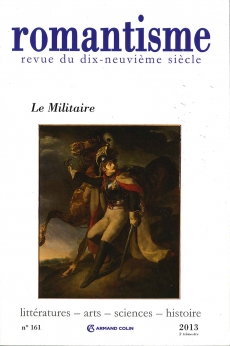
Romantisme n° 161 (3/2013)
Pour acheter ce numéro, contactez-nous
Recevez les numéros de l'année en cours et accédez à l'intégralité des articles en ligne.
Au cours du XIXe siècle est née en France une production culturelle divertissante prenant pour sujet l’armée et ses représentants. Apparue au théâtre dès la Restauration, déployée ensuite dans la presse, notamment la presse satirique illustrée puis dans les circuits populaires de la littérature et sur les scènes des cafés-concerts, le comique troupier construit la place du militaire dans l’imaginaire social. Ces textes et ces images mettent en scène des types sociaux qui confortent les normes genrées et suscitent le rire selon des procédés rhétoriques répétitifs. Si leurs auteurs épinglent les travers d’une institution longtemps tenue éloignée de la nation, cette fonction critique tend néanmoins à s’étioler après la généralisation du service militaire en 1872. À la fin du XIXe siècle, cette production hybride répond aux attentes d’un public soucieux de se familiariser avec l’armée, non sans conserver aux yeux de l’institution militaire un pouvoir contestataire dont celle-ci ne peut négliger le rôle.
During the 19th century emerged in France a cultural production, focused on entertainment, whose subject matter was the army and its representative characters. The genre of the “comique troupier” or coarse comedy focused on military characters first appeared in the theatres of the Restoration, then spread to the newspapers, especially in the satirical illustrated press, to popular literature and to the stages of the cafés-concerts, and built up the role and image of the army in the popular imagination. These texts and these pictures depict social types that reinforce gender norms and arouse laughter by repetitive rhetorical devices. If the authors first pinpointed the defects of an institution that long stood aloof from the nation, this critical function tended to wane after the generalization of the military service in 1872. At the end of the nineteenth century, this hybrid production was responding to a public eager to know more about army life, while nonetheless continuing to have from the point of view of the institution itself a role as crotic that the army had to take into account.

